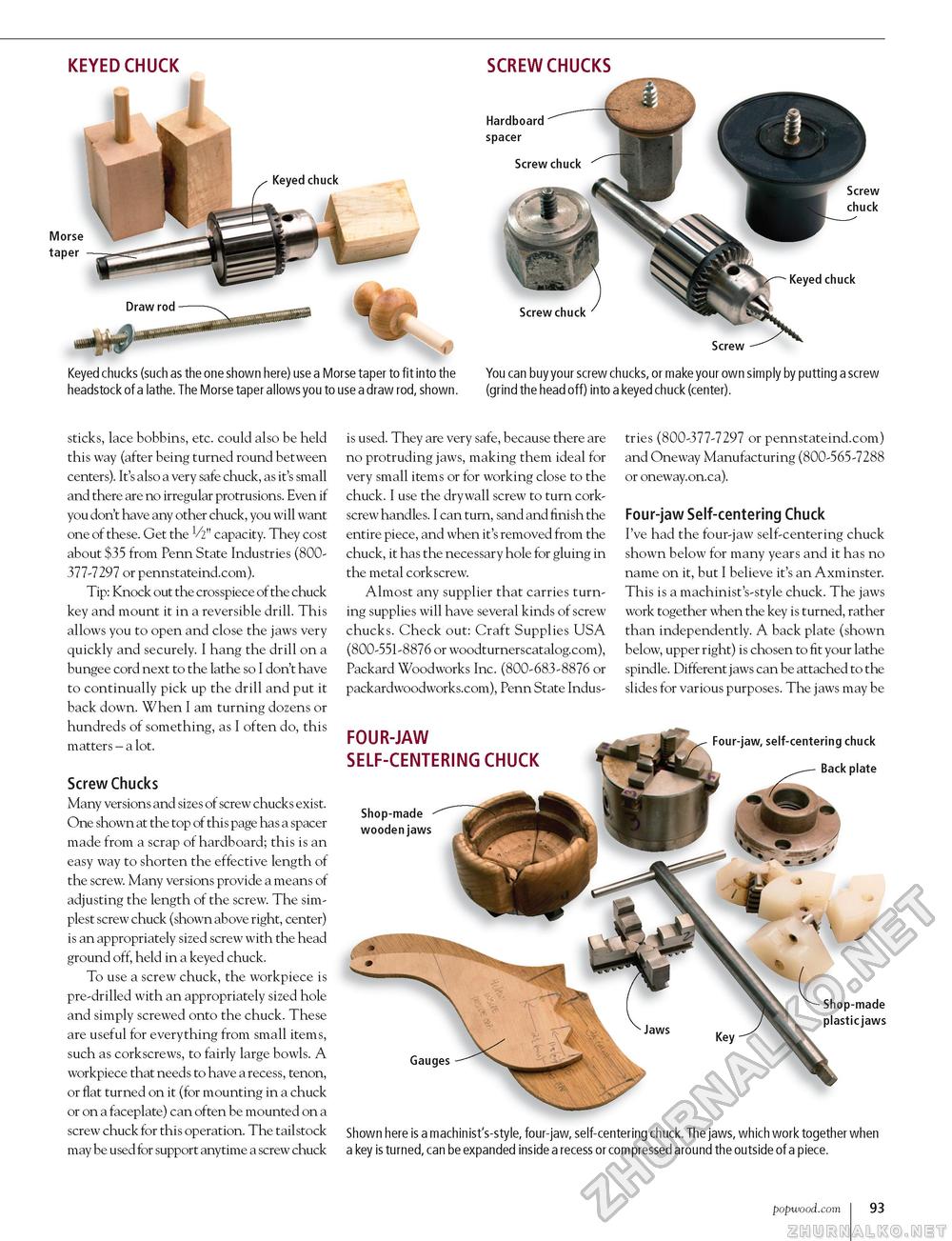Popular Woodworking 2005-02 № 146, страница 98
KEYED CHUCK M Morse taper ■ Keyed chucks (such as the one shown here) use a Morse taper to fit into the headstock of a lathe. The Morse taper allows you to use a draw rod, shown. SCREW CHUCKS Hardboard spacer Screw chuck Screw You can buy your screw chucks, or make your own simply by putting a screw (grind the head off) into a keyed chuck (center). sticks, lace bobbins, etc. could also be held this way (after being turned round between centers). It's also a very safe chuck, as it's small and there are no irregular protrusions. Even if you don't have any other chuck, you will want one of these. Get the V2" capacity. They cost about $35 from Penn State Industries (800377-7297 or pennstateind.com). Tip: Knock out the crosspiece of the chuck key and mount it in a reversible drill. This allows you to open and close the jaws very quickly and securely. I hang the drill on a bungee cord next to the lathe so I don't have to continually pick up the drill and put it back down. When I am turning dozens or hundreds of something, as I often do, this matters - a lot. Screw Chucks Many versions and sizes of screw chucks exist. One shown at the top of this page has a spacer made from a scrap of hardboard; this is an easy way to shorten the effective length of the screw. Many versions provide a means of adjusting the length of the screw. The simplest screw chuck (shown above right, center) is an appropriately sized screw with the head ground off, held in a keyed chuck. To use a screw chuck, the workpiece is pre-drilled with an appropriately sized hole and simply screwed onto the chuck. These are useful for everything from small items, such as corkscrews, to fairly large bowls. A workpiece that needs to have a recess, tenon, or flat turned on it (for mounting in a chuck or on a faceplate) can often be mounted on a screw chuck for this operation. The tailstock may be used for support anytime a screw chuck is used. They are very safe, because there are no protruding jaws, making them ideal for very small items or for working close to the chuck. I use the drywall screw to turn corkscrew handles. I can turn, sand and finish the entire piece, and when it's removed from the chuck, it has the necessary hole for gluing in the metal corkscrew. Almost any supplier that carries turning supplies will have several kinds of screw chucks. Check out: Craft Supplies USA (800-551-8876 or woodturnerscatalog.com), Packard Woodworks Inc. (800-683-8876 or packardwoodworks.com), Penn State Indus tries (800-377-7297 or pennstateind.com) and Oneway Manufacturing (800-565-7288 or oneway.on.ca). Four-jaw Self-centering Chuck I've had the four-jaw self-centering chuck shown below for many years and it has no name on it, but I believe it's an Axminster. This is a machinist's-style chuck. The jaws work together when the key is turned, rather than independently. A back plate (shown below, upper right) is chosen to fit your lathe spindle. Different j aws can be attached to the slides for various purposes. The jaws may be Shown here is a machinist's-style, four-jaw, self-centering chuck. The jaws, which work together when a key is turned, can be expanded inside a recess or compressed around the outside of a piece. popwood.com 93 |








